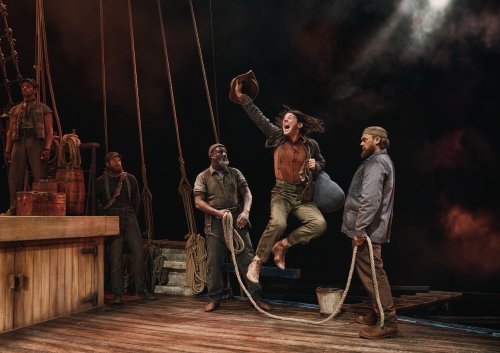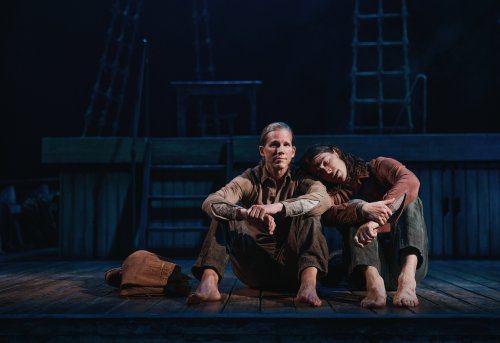Swept Away
An attempt to put on stage the breath and excitement of an 19th century sea voyage and all its dangers.

The Company of the new musical “Swept Away” at the Longacre Theatre (Photo credit: Emilio Madrid)
The new Broadway musical Swept Away directed by Michael Mayer is an attempt to put on stage the breadth and excitement of an 19th century sea voyage and all its dangers. With an original book by John Logan (The Last Ship) and songs from the catalog of the legendary Avett Brothers, the fictional plot is based on their 2004 album and the true story of the Mignonette, a yacht that sank in 1884 and left four seamen stranded in a lifeboat for 24 days with tragic results.
Visually the musical is stunning with a realistic ship set by Rachel Hauck and lighting by Kevin Adams, as well as appropriate sound effects by John Shivers. The only problem with the show is that the book has about 15 minutes of dramatic events stretched out to 95 minutes, and the predictable ending will be known to those of the audience who have heard the story of the Mignonette, or have read about the SS Essex, or seen the film made from that tale.

Wayne Duvall, John Gallagher, Jr., Stark Sands and Adrian Blake Enscoe in a scene from the new musical “Swept Away” at the Longacre Theatre (Photo credit: Emilio Madrid)
Logan’s book fictionalizes the story of the sinking of the British yacht Mignonette in 1884 on its way from Britain to Australia and instead makes it about an American whaling ship out of New Bedford in the days when paraffin and kerosene were replacing the need for whale oil in 1888. The Mate, the last surviving member of the crew of the doomed ship, lies dying in a tubercular hospital in New York in 1910, 22 years after the tragic events that he recalls. He is haunted by the voices of the crew from the ship he sailed on that sank in the Atlantic as he hears them crying out for him to “tell our story,” the tale which is mostly his and the other three survivors of the wreck.
The time flashes back to 1888, the last voyage for a ship intended for the scrap yard after this final expedition. The captain awaits his last crew member who is late, a wide-eyed 18-year-old New Englander who wants more of life than the farm he grew up on. He arrives soon after with his older brother hot on his heels to bring him back home and save him from the dissolute life of a sailor. When Big Brother tries to get off the ship, he finds that it has set sail and he is trapped for the duration of the voyage.

Adrian Blake Enscoe and the Company of the new musical “Swept Away” at the Longacre Theatre (Photo credit: Emilio Madrid)
Five days out on the Atlantic, the Captain has a premonition of bad weather having seen green twinkling phosphorus on the ocean, and is proved right when a ferocious storm comes up and capsizes the ship. Only four men survive on the lifeboat that is left afloat: the Mate (John Gallagher, Jr.), the Captain (Wayne Duvall), Big Brother (Stark Sands) and Little Brother (Adrian Blake Enscoe), with one of them gravely wounded. They are adrift on the seas for 21 days without food or water, without protection from the terrible sun and rain; one needs to be sacrificed to keep the others alive. How the tragic events play out is the main plot of the show.
Besides the fact that many know the story of the Essex (later told in Melville’s Moby Dick) or the Mignonette told in The Avett Brothers’ album of the same name, Logan has made his main characters totally generic without given names. We learn too little about each for them to be three-dimensional characters: the Mate, cynical and corrupt; the Captain, at the end of a long career, melancholy and philosophical; Big Brother, religious and judgmental, and Little Brother, innocent and curious. A knife is flashed soon after the survivors find themselves on the lifeboat and we know how that will end. Just like the voyage of the whaling ship, their time on the lifeboat is a waiting game: how long can they survive and who will be the first to go?

Stark Sands as “Big Brother” and Adrian Blake Enscoe as “Little Brother” in a scene from the new musical “Swept Away” at the Longacre Theatre (Photo credit: Emilio Madrid)
The eclectic sound of the Avett Brothers’ songs described as combining country, folk, bluegrass, pop, rock and roll, indie rock and ragtime is nowhere in evidence and the pleasant score sounds like traditional folk music. The sources of the Avett Brother’s score are five songs from their 2004 “Mignonette” album, four from the “True Sadness,” 2016 album, two from “Te Carpenter,” 2012, and one each “Emotionalism” (2007) and “The Second Gleam” (2006) albums. Ironically, the most effective song in the context of the show is “Lord Lay Your Hand on My Shoulder” first sung as a prayer, and later as a lullaby. Both Chris Miller and Brian Usifer are both credited with the effective arrangements and orchestrations which feature both electric and acoustic guitar solos.
The large male ensemble of 12 singers as the crew is neither given names nor much to do before the ship sinks. The four survivors are well acted though we learn little about them. Gallagher, Jr. as the Mate and Narrator is decidedly creepy as he brags of evil deeds and dissolute behavior in various ports. Grizzled and hirsute, Duvall’s Captain is moody and dark as he reviews his career and his unknowable future. Sands as Big Brother seems to be a religious fanatic, one whose brother is both repelled by his narrowness and attracted to the goodness he radiates. As Little Brother, the youngest crew member, Enscoe is inexperienced and eager to see the world outside of the farm he grew up on. All their interactions are mainly based on these few character traits.

John Gallagher, Jr. and the Company of the new musical “Swept Away” at the Longacre Theatre (Photo credit: Emilio Madrid)
When the audience enters the theater, the curtain is up and Hauck’s ship’s realistic main deck and its rigging are visible. Adams’ lighting includes the play of light on the water and the stars above on the dark sky over the ocean. The ship’s sinking is quite a feat and may take your breath away, as it reveals the lifeboat on the water under it. Somehow (uncredited) a cold wind is piped into the audience making the storm all that much more palpable besides the thunder and the lightning. Throughout the second half of the show, the lifeboat turns as though adrift on the sea. Susan Hilferty’s shabby, lived-in sailor’s togs complement the authenticity of the set.
While Swept Away is professionally staged, the limitations of John Logan’s story and characterization undermine its power and theme, the same fault to be found with his co-writing credit on the book for Sting’s The Last Ship in 2014. The score by the Avett Brothers is worth hearing but the show at the Longacre Theatre seems more like an expensively staged concert performance than a dramatic musical. While Michael Mayer’s work on the show is commendable, he has not been able to help shape the story and the characters into anything more than a superficial drama but visually impressive stage spectacle.
Swept Away (through December 29, 2024)
Longacre Theatre, 220 W. 48th Street, in Manhattan
For tickets, visit http://www.sweptawaymusical.com
Running time: 95 minutes without an intermission






Leave a comment